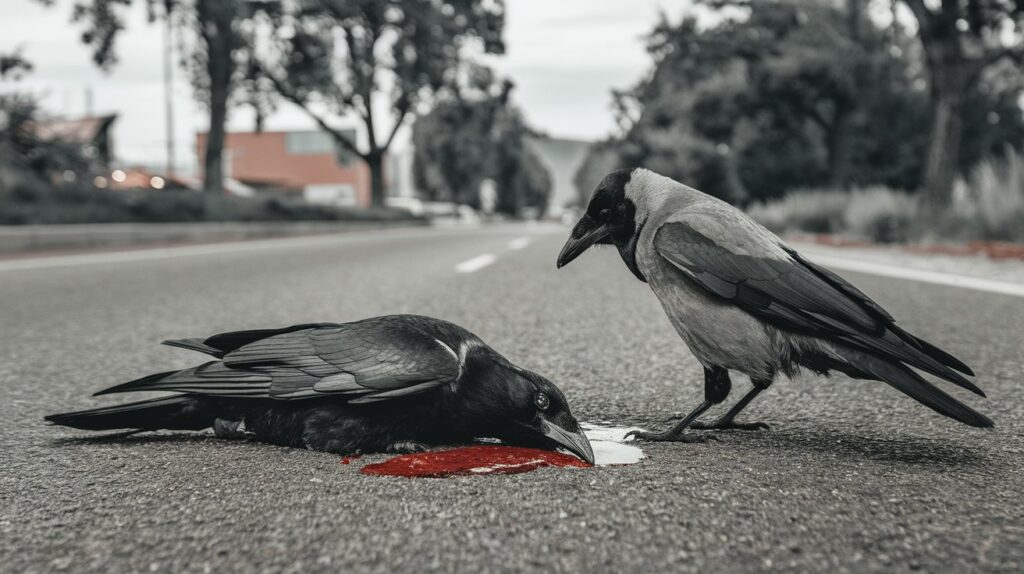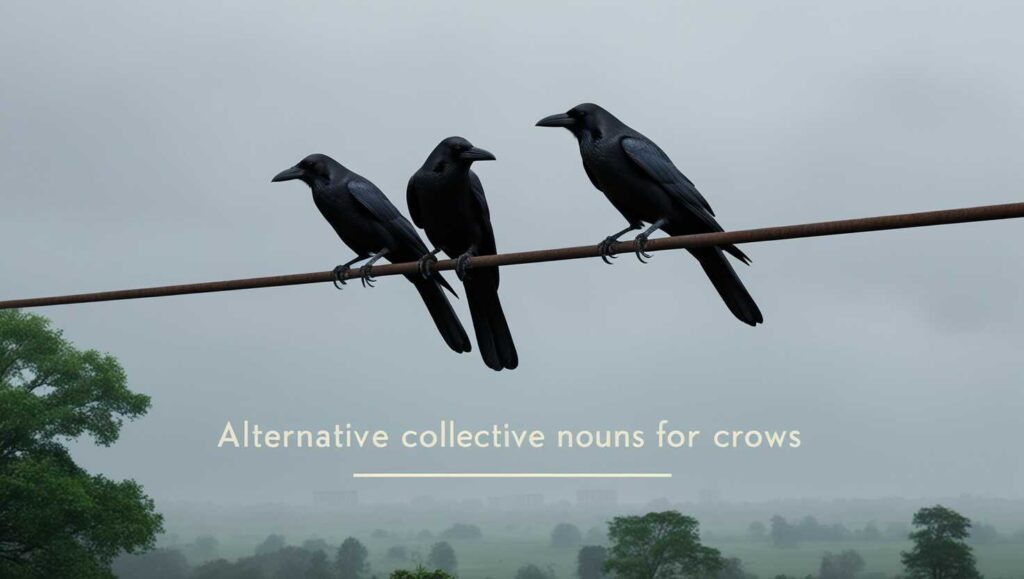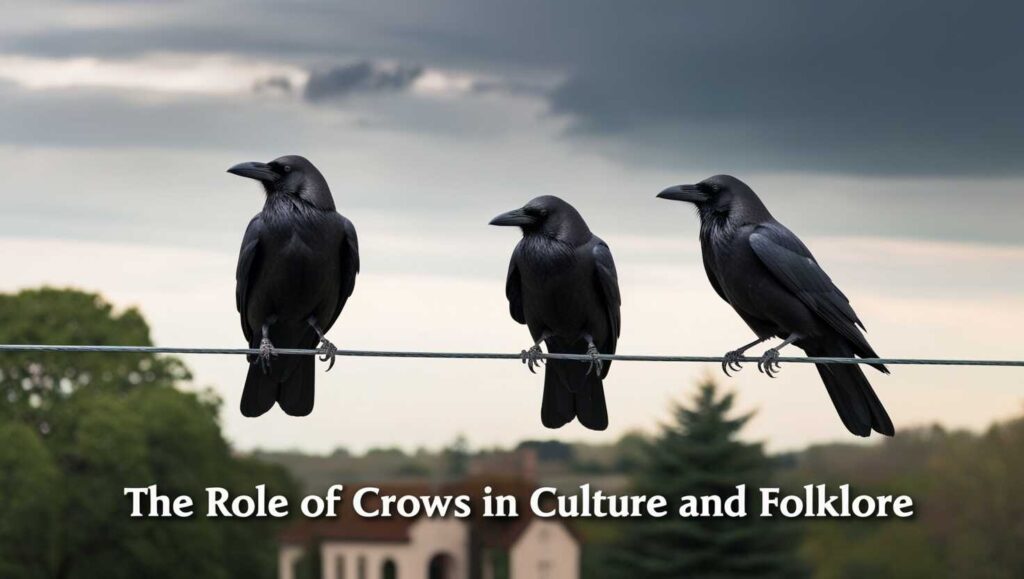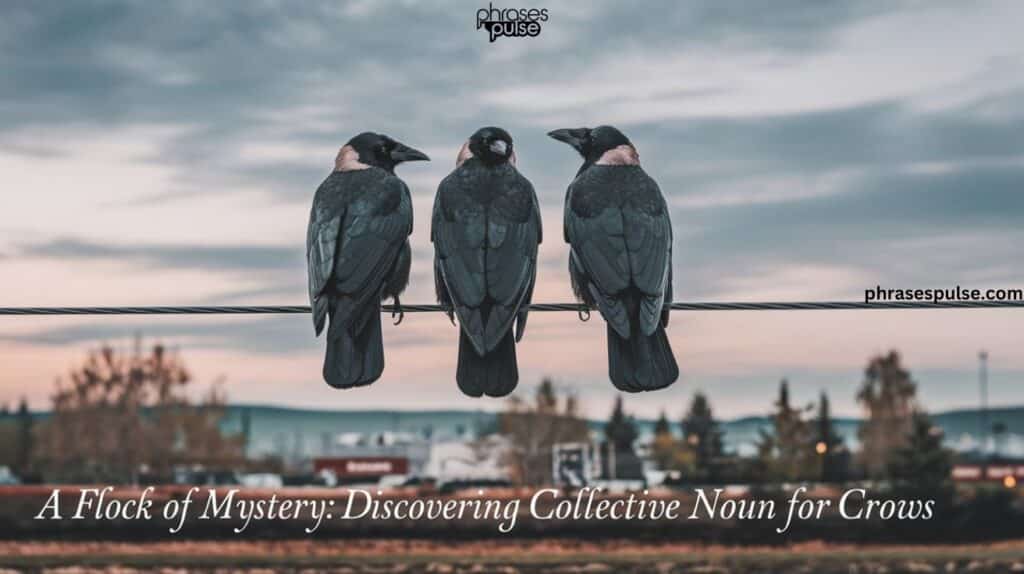Collective noun for crows captures our imagination, reflecting the mystery and intelligence these birds embody. Often associated with both wonder and foreboding, the terms we use to describe a group of crows paint vivid mental images.
For instance, the phrase “murder of crows” conjures up captivating yet dark scenes. In this article, we’ll dive into the collective noun for crows, exploring its meanings, origins, and how language influences our perception of these remarkable creatures.
Understanding Collective Nouns
A collective noun is a word that describes a group of individuals, animals, or objects as a single entity. Collective nouns enrich our language, allowing us to convey more than just numbers. Instead of saying “a group of birds,” we can say “a flock of crows,” which gives us more context and imagery.
The Significance of Collective Nouns
Using specific collective nouns can significantly enhance communication. For example, saying “a murder of crows” evokes a more intense image than simply stating “a group of crows.”
Each term carries its own connotations and helps to shape our understanding of the animals involved. Here’s a brief look at the implications of using different collective nouns:
| Collective Noun | Connotation |
|---|---|
| Murder | Darkness, mystery, foreboding |
| Flock | Neutral, general grouping |
| Horde | Overwhelming numbers, chaotic presence |
| Parliament | Intelligence, decision-making |
| Storytelling | Knowledge-sharing, cultural significance |
The Most Famous Collective Noun: Murder of Crows

The term murder of crows stands out as the most notorious collective noun associated with these birds. But what lies behind this unsettling term?
Historical Context
The word “murder” connected with crows has roots dating back to medieval Europe. During this time, crows often scavenged on battlefields, feeding on the remains of fallen soldiers.
This behavior solidified their association with death and misfortune. People viewed them as ominous creatures, and the idea of a “murder” arose from the perception that they foretold doom.
Symbolism of the Term
The murder of crows evokes a sense of danger and intrigue. Crows are often seen as harbingers of death, and their dark plumage and eerie cawing contribute to this reputation. However, this symbolism also reflects their intelligence and adaptability.
Crows are highly social animals, and their gatherings often display complex behaviors, such as coordinated movements and vocal communications.
Their intelligence can be unsettling, as it challenges our understanding of what it means to be a “bird.” Crows can solve puzzles, use tools, and even recognize human faces, making them far more than mere symbols of death.
Alternative Collective Nouns for Crows

While murder is the most recognized term, various other collective nouns for crows exist, each with its own unique implications. Here are some intriguing alternatives:
| Collective Noun | Description |
|---|---|
| Murder of Crows | The most common and well-known term, associated with death and mystery. |
| Flock of Crows | A general, neutral term used for many types of birds. |
| Horde of Crows | Suggests a large, overwhelming gathering of crows. |
| Parliament of Crows | Implies intelligence and deliberation, like a council or meeting. |
| Storytelling of Crows | A rare term, highlighting their association with myth and wisdom. |
| Unkindness of Crows | Reflects a darker view of their behavior, often used for ravens. |
| Conspiracy of Crows | Another term that emphasizes secrecy and mystery, often used for ravens. |
| Gang of Crows | Suggests a group that is unruly or intimidating. |
| Crowd of Crows | A simple term denoting a large number of crows. |
| Cauldron of Crows | Evokes imagery of witches and potions, linked to crows’ dark reputation. |
| Rascal of Crows | Highlights the playful or mischievous nature of these birds. |
| Mob of Crows | Refers to a noisy or aggressive gathering. |
| Clan of Crows | Suggests a familial or tight-knit group of crows. |
| Quarrel of Crows | Indicates a noisy, possibly confrontational group. |
| Tiding of Crows | Implies a gathering that brings news, often bad news or omens. |
- Flock of Crows: This neutral term can apply to many bird species. It emphasizes the simple act of gathering without the ominous connotations associated with “murder.”
- Horde of Crows: This term suggests a large, chaotic grouping of crows. When crows gather in significant numbers, they can create a striking visual and auditory spectacle.
- Parliament of Crows: This term draws on the idea of intelligence and discussion among the birds. Just as a parliament debates and makes decisions, this collective noun suggests that crows are engaged in meaningful interactions.
- Storytelling of Crows: While less common, this phrase emphasizes the cultural significance of crows as symbols of wisdom and knowledge. In many cultures, crows are seen as keepers of stories, passing down tales through generations.
Why Variations Exist
Different cultures and regions have shaped their own collective nouns based on their experiences and observations of crows. Each term reflects distinct aspects of crow behavior and societal perceptions.
For example, the collective term for ravens often includes words like unkindness or conspiracy, emphasizing their darker reputation, much like crows.
The Role of Crows in Culture and Folklore

Crows hold a significant place in folklore, mythology, and literature across cultures. Their presence in stories often reflects human fears and fascinations. Let’s explore some notable cultural references to crows.
Crows in Literature
Crows often appear in literature as symbols of foreboding. For instance, William Shakespeare used crows to signify dark omens in plays such as Macbeth. The lines and imagery conjured by crows often evoke a sense of unease or impending doom.
Edgar Allan Poe’s poem “The Raven” reinforces this connection, although it focuses on a raven rather than a crow. The poem encapsulates the theme of loss and despair, illustrating how black birds can symbolize deeper emotional struggles.
Crows in Mythology
In Norse mythology, the god Odin had two ravens, Huginn and Muninn, who flew around the world, gathering information. These ravens represented thought and memory, showcasing the intelligence often attributed to their avian relatives, including crows.
In Native American culture, crows are seen as tricksters and protectors. Some peoples believe that crows can bridge the gap between the living and the dead, imbuing them with spiritual significance.
Quotes Reflecting Cultural Views
Crows have inspired various quotes that highlight their complexity. For instance, the saying, “As wise as an owl, but as cunning as a crow,” suggests a balance between intelligence and deceit. This perspective helps us appreciate the multifaceted nature of crows in human culture.
Why the “Murder” Endures

The term murder of crows has persisted throughout the centuries for several reasons, including psychological and cultural factors.
Psychological Impact of Words
The word murder immediately captures attention, creating a sense of intrigue. Its connotations evoke a vivid mental image, enhancing our understanding of the group dynamics among crows. When we hear “murder,” we’re compelled to visualize the scene, which is often unsettling yet fascinating.
Cultural Longevity
The murder of crows has remained a prevalent term in popular culture, appearing in literature, films, and art. The repeated use of this term reinforces its connection to darkness and mystery.
For example, in modern media, crows often symbolize secrets or untold stories, continuing the tradition of associating them with the unknown.
Contemporary References
Popular culture keeps the term alive. Movies like The Crow and series such as Game of Thrones utilize black birds to convey themes of darkness and foreboding. The phrase “dark wings, dark words” exemplifies this enduring connection, showcasing how language evolves but retains its roots in cultural understanding.
Real-Life Context and Observations
To understand the collective noun for crows more deeply, let’s examine real-life observations of these birds in action.
Behavior of Crows in Groups
Crows often gather in significant numbers, exhibiting fascinating social behaviors. Their interactions can be loud and chaotic, especially when they feel threatened or are defending their territory.
Imagine walking through a park when you suddenly hear the raucous cawing of crows overhead. You look up to see a murder of crows swooping through the trees, their wings beating in unison. The sight can be both awe-inspiring and unsettling, showcasing the power of these birds when they come together.
Anecdotal Evidence
Many bird watchers and nature enthusiasts have recounted their experiences observing crows. One enthusiast shared a story about a group of crows working together to steal food from a picnic. Their coordinated efforts were impressive, highlighting their intelligence and social structure.
frequently asked questions
1. What is the collective noun for crows?
The collective noun for crows is a “murder.”
2. What is a flock of crows called?
A flock of crows is also referred to as a “murder.”
3. What is a synonym for flock of crows?
A synonym for a flock of crows is “flock,” but “murder” is the specific term.
4. What is the scientific name for a group of crows?
There isn’t a scientific name specifically for a group of crows; they belong to the family Corvidae.
conclusion
Crows are more than just birds they embody complexity, intelligence, and mystery. The murder of crows is just one of many collective nouns for crows that help us understand the nature of these fascinating creatures. As you reflect on the rich history and meanings behind these terms, you might find yourself appreciating crows more deeply.
The next time you encounter a group of crows, remember the stories, symbols, and insights they carry with them. Whether you view them as omens or intelligent problem-solvers, these dark feathered beings will continue to captivate our imagination.
As you observe crows in your daily life, consider the collective term for ravens and the myriad of associations it holds. The world of language and nature intertwines in beautiful, mysterious ways, and crows are at the heart of that connection.

Ava Rose, the creator of PhrasesPulse, is an expert in English grammar with years of experience. She is dedicated to simplifying complex grammar rules and exploring the richness of English phrases. Through her insightful posts, Ava aims to help learners of all levels enhance their understanding of the language and communicate more effectively. Her passion is making grammar approachable and enjoyable for everyone.







